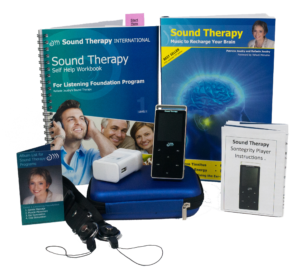I am always talking about the middle ear muscles – it fascinates me that these muscles play an active role in how our ear functions. We all understand muscles from our day to day experience. We know how they perform, can get strained, and can be trained and built up to gain strength. They can also become over tight, chronically stiff, and need considerable time and therapy to regain a nice soft, relaxed, pliable tone.
The theory behind Sound Therapy is that the ear is an active organ whose role is to stimulate and enhance brain pathways. The tiny muscles in the middle ear respond to certain types of sound stimulation, making the whole auditory system into a dynamic revitalising tool for the brain. Special filtering algorithms (or patterns) and high frequency filters are used to enhance classical music so that it becomes an intensive, progressive therapy program.
Sound Therapy was originally developed by the ear specialist Dr Tomatis, in conjunction with the Sorbonne University in Paris. However, many of his theories have not been sufficiently researched to gain widespread acceptance. Now, finally, we are seeing new innovative research that is starting to confirm some of Tomatis’s ideas. Some of this is new neuro-physiological research from America.
Stephen Porges Ph.D., the Director of the Brain-Body Center, at the University of Illinois at Chicago has developed Polyvagal theory which explains how the vagus nerve acts through the autonomic (automatic-unconscious) nervous system to control our social-emotional processes. According to Dr. Porges, many children with developmental disabilities are in a state of high anxiety. As a result, it is difficult for them to attend to the high frequency sounds such as human speech.
Stephen Porges may be closing in on the reason why auditory re training with sound therapy is proving beneficial to children with autism and other related disorders. In doing this, he is also demonstrating why, for people in general, Sound Therapy seems to enhance communication and relationships.
You can read more about Porges’ research on this link. http://www.education.umd.edu/EDHD/faculty2/Porges/tlp/tlp.html
Porges has found that the same nerves that control the two muscles in the middle ear also control vocalization, facial expression, heart rate and breathing.
When we experience fear and or anxiety, the middle ear muscles can no longer diminish and limit the impact of low-frequency sounds.
Based on an evolutionary perspective, this would allow the individual to attend to all sounds in the environment, in order to perceive danger, rather than attending mostly to higher frequency sounds such as speech.
According to Dr. Porges, many children with developmental disabilities are in a state of high anxiety. This makes it difficult for them to pay attention to only the high frequency sounds such as human speech.
Porges is experimenting with a form of sound stimulation that is similar to the Tomatis method. After being encouraged to relax and do relaxing activities, the child then listens to specific sounds or music that conforms to a narrow frequency range, similar to the range of human speech.
This frequency range is then gradually widened, which is intended to vigorously exercise the two muscles in the middle ear.
Since the middle ear muscles share the same neural connection with facial expression and vocalization, Dr. Porges expected to see an improvement in communication as a result of an improvement in middle ear function. His 10 years of research on this subject has supported this hypothesis.
Porges research is all based on his theories about the Vagus nerve, a fascinating nerve linking many parts of the body. Emerging from the skull, the vagus then communicates with the heart, lungs and digestive tract, also regulating muscles of the head including the face, middle ear, mouth, larynx, and upper throat.
When they studied the general function of these muscles, they realized that collectively these muscles provide an integrated Social Engagement System which controls looking, listening, vocalizing, and facial gesturing.
Porges puts forward some very interesting points about these muscles.
1. “First, if the neural regulation of this group of muscles were dysfunctional, we would observe a face that did not work in social settings.
2. “Second, the middle ear muscles play an important role in extracting human voice from our complex acoustic environment. When the neural tone to the middle ear muscles is low, the middle ear structures do not actively filter out the low frequency sounds that dominate the acoustic environment of our modern industrial world and do not amplify the frequencies associated with human voice.
3. “Third, the neural regulation of the middle ear muscles is linked to the neural regulation of the other muscles of the face, which control facial expression and vocal intonation.”
This means that using stimulation to improve neural regulation of the middle ear muscles should integrate and stimulate the neural regulation of facial expression, looking, listening, and vocalizing.
Like Porges protocol, Sound Therapy aims to enhance the ability to extract the human voice in social settings via the cortical neural regulation of the middle ear muscles. (i.e. control of the ears by the brain.) this is why Sound Therapy listeners typically find it enhances their ability to follow a conversation in a noisy environment.
The filtering process we use is part of a complex algorithm that modulates the intensity of various frequencies to “exercise” and “stimulate” the neural regulation of the middle ear muscles and serves to integrate the components of the Social Engagement System.
This would explain why Sound Therapy listeners report better communication, self expression, receptive listening, and therefore better relationships!


